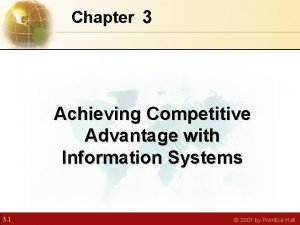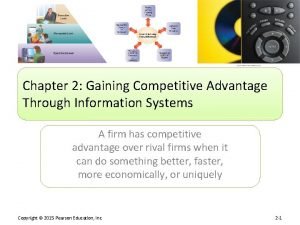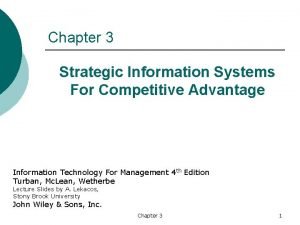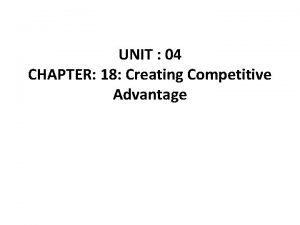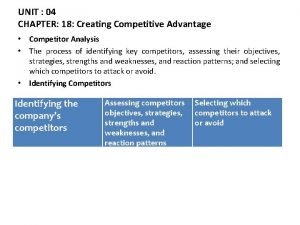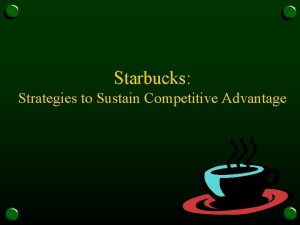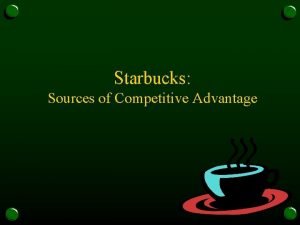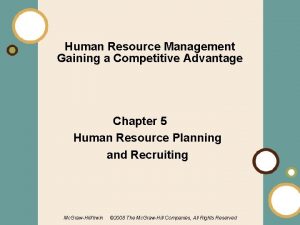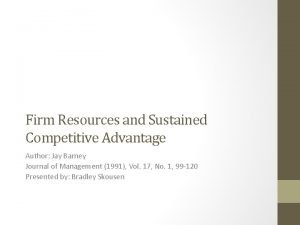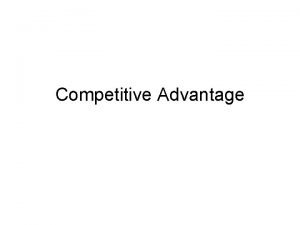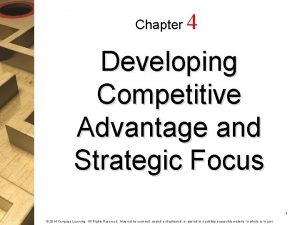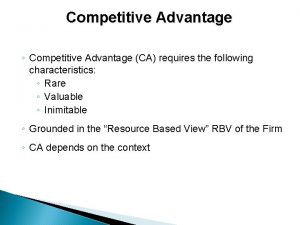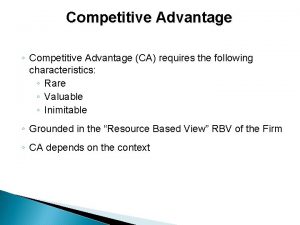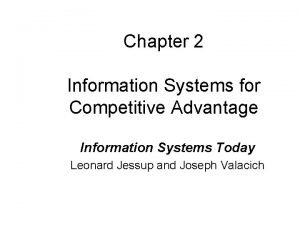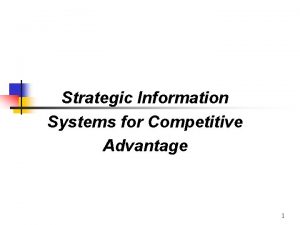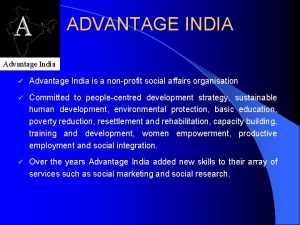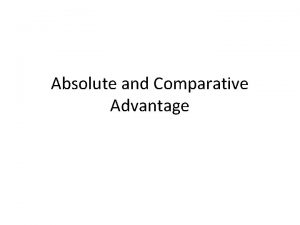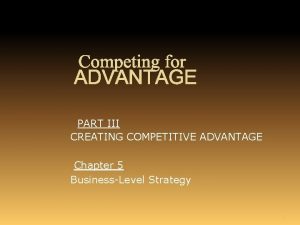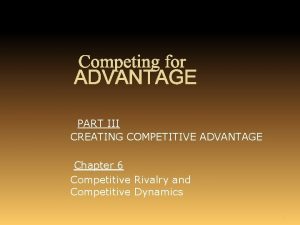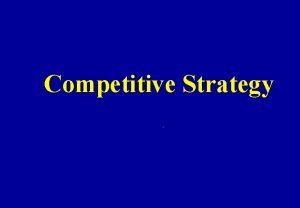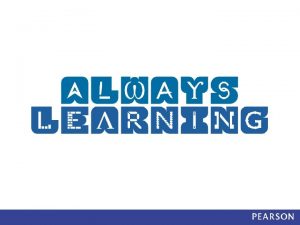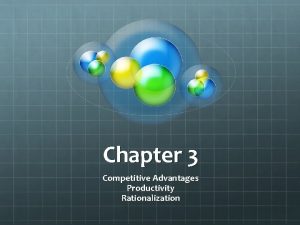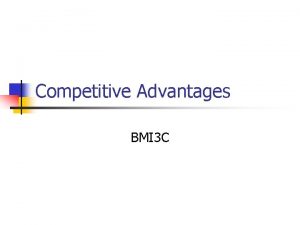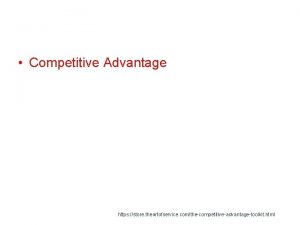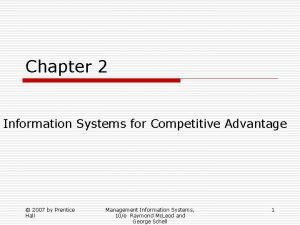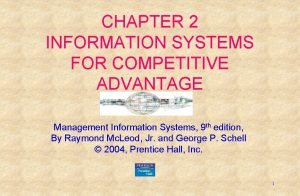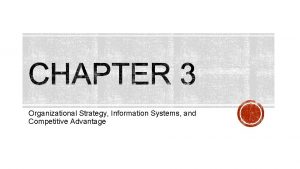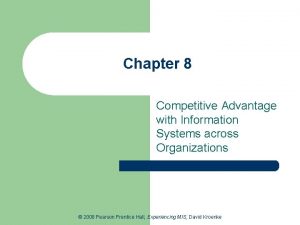INFORMATION SYSTEMS for Competitive Advantage Competitive Advantage Learning
























- Slides: 24

INFORMATION SYSTEMS for Competitive Advantage

“Competitive Advantage” Learning Goals a. Discuss how IS can be used in organizations b. Describe the strategic importance of IS to the success of modern organizations. c. Formulate and present the business case for a system and understand why it is sometimes difficult to do so. d. Explain why and how companies are continually looking for new ways to use technology for competitive advantage.

2 a. How IS Can Be Used in Organizations Automating – Doing Things Faster Organizational Learning – Doing Things Better Supporting Strategy – Doing Things Smarter

2 a. How IS Can Be Used in Organizations Automating (1 of 3) Using technology to complete a task – faster, – more cheaply, and – perhaps with greater accuracy/consistency

2 a. How IS Can Be Used in Organizations Organizational Learning Using technology to better understand improve the day-to-day activities within the process (2 of 3)

2 a. How IS Can Be Used in Organizations Strategic Planning (3 of 3) u The best way to use information systems u Uses IS strategically to enable the firm to gain or sustain competitive advantage over its rivals

2 b. Critical Importance of IS Types of Competitive Advantage (1 of 7) Low-Cost Leadership – Best prices on goods/services Differentiation – Best quality goods/services Best-Cost Provider (middle-of-the-road) – Reasonable quality, competitive prices

2 b. Critical Importance of IS Organizational Strategies (2 of 7)

2 b. Critical Importance of IS IS for Competitive Advantage (3 of 7) A clear strategy is essential Sources of competitive advantage: – – – – Best-made product Superior customer service Lower costs Superior manufacturing technology Shorter lead times Well-known brand name High value per cost

2 b. Critical Importance of IS IS and Value Chain Analysis (4 of 7) Views organizations as big input/output systems IS can automate many value chain activities: – Purchased supplies inbound logistics – Operations – Outbound logistics – Sales and marketing – Service

2 b. Critical Importance of IS IS and Value Chain Analysis (5 of 7)

2 b. Critical Importance of IS IS for Competitive Advantage (6 of 7) Role of IS in Value Chain Analysis – Provides potential competitive advantages at various parts in the chain Internet link with suppliers, dealers – Extranets: using the Internet for B 2 B interactions Computer-aided manufacturing systems Web site with online product ordering Customer service response system Computer-aided design

2 b. Critical Importance of IS IS for Competitive Advantage (7 of 7) The Technology/Strategy Fit – Every organization can’t build every possible system (due to financial and time constraints) – Need to match systems used with overall organizational strategy. There may need to be significant organizational change in order for a system to be successful

2 c. Making the Business Case for a System The Productivity Paradox (1 of 4) Usually easy to quantify costs Difficult to quantify gains – Measurement problems – End-user development – Decision support systems (DSS) – Strategic systems – Time lags – Redistribution – Mismanagement

2 c. Making the Business Case for a System General Approaches (2 of 4) – Arguments Based on Faith – Arguments Based on Fear Stage of industry maturity Degree of Regulation Nature of Competition or Rivalry – Arguments Based on Facts Cost-benefit analysis for a web-based system – Recurring/nonrecurring costs – Tangible/intangible benefits

2 c. Making the Business Case for a System Things to Remember Know the Audience – The IS Manager – Company Executives (VPs and higher) – Steering Committee Try to Convert all Benefits into Monetary Terms (3 of 4)

2 c. Making the Business Case for a System Things to Remember (4 of 4) If can’t use Monetary Variables, then Devise Proxy Variables – Measure changes in terms of perceived value Develop a Work Profile Matrix – Time spent on each job, each type of work Be sure to Measure What Management Considers to Be Important Try to Change Mindsets About Information Systems from a Necessary Evil to a Competitive Asset

2 d. Competitive Advantage in Being at the Cutting Edge What is Meant by Being at the Cutting Edge? (1 of 7) Deploying new technologies faster, better, and cheaper than competitors Using new technology in innovative ways

2 d. Competitive Advantage in Being at the Cutting Edge What is Meant by Being at the Cutting Edge? (2 of 7) The Need for Constant IS Innovation Always on the lookout for new technologies that impact business

2 d. Competitive Advantage in Being at the Cutting Edge E-Business Innovation Cycle (3 of 7) Choosing – enabling/emerging technologies Matching – with economic opportunities Executing – business innovation for growth Assessing – client value

2 d. Competitive Advantage in Being at the Cutting Edge E-Business Innovation Cycle (4 of 7)

2 d. Competitive Advantage in Being at the Cutting Edge Implications of the E-Business Innovation Cycle (5 of 7) Begin with the technology when considering successful business strategies Marketing is secondary to IT Emerging technology cycle is ongoing

2 d. Competitive Advantage in Being at the Cutting Edge Painful Realities of Being at the Cutting Edge (6 of 7) Information systems are often bought from, or built by, someone else An organization typically cannot patent an IS Rivals can copy emerging information systems Therefore, one’s IS competitive advantage can be short-lived

2 d. Competitive Advantage in Being at the Cutting Edge Requirements for Being at the Cutting Edge (7 of 7) To deploy emerging systems well: – Organization must adapt well to change – Human capital must be available for deployment (knowledge, time, skills) – Tolerance of risk and uncertainty
 Achieving competitive advantage with information systems
Achieving competitive advantage with information systems Gaining competitive advantage through information systems
Gaining competitive advantage through information systems Advantages of strategic information system
Advantages of strategic information system What is the least competitive market structure
What is the least competitive market structure Pharmacology introduction
Pharmacology introduction Standard cycle market example
Standard cycle market example Cuadro comparativo entre e-learning b-learning y m-learning
Cuadro comparativo entre e-learning b-learning y m-learning Value creation strategy
Value creation strategy Chapter 18 creating competitive advantage
Chapter 18 creating competitive advantage Jay barney competitive advantage
Jay barney competitive advantage Starbucks sustainable competitive advantage
Starbucks sustainable competitive advantage Starbucks firm infrastructure
Starbucks firm infrastructure Human resource management gaining a competitive advantage
Human resource management gaining a competitive advantage Human resource management gaining a competitive advantage
Human resource management gaining a competitive advantage Human resource management gaining a competitive advantage
Human resource management gaining a competitive advantage Levi's competitive advantage
Levi's competitive advantage Barney 1991 firm resources
Barney 1991 firm resources Quotes on competitive advantage
Quotes on competitive advantage Bases of competitive advantage
Bases of competitive advantage Four building blocks of competitive advantage
Four building blocks of competitive advantage Developing a firm's strategy canvas focuses on
Developing a firm's strategy canvas focuses on Searching for loose bricks
Searching for loose bricks Creating and sustaining competitive advantage
Creating and sustaining competitive advantage Mis competitive advantage
Mis competitive advantage Strategic planning for competitive advantage
Strategic planning for competitive advantage
